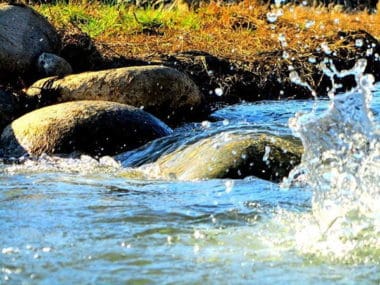If You Only Knew…Saint Teresa and the Waters of Prayer
(Part I of II)
Jesus tired and thirsty sat down at a well and there encountered a Samaritan woman who had come to draw water. Asking her for a drink, He said to her,
“‘If you knew the gift of God and who is saying to you, Give me a drink, you would have asked him and he would have given you living water… Everyone who drinks of this water will be thirsty again, but those who drink of the water that I will give them will never be thirsty. The water that I will give will become in them a spring of water gushing up to eternal life.’” (cf John 4:6, 10, 13-14)
Water is mentioned 722 times in the scriptures. In the Genesis account of creation, in the very first chapter and in the second line, we learn one thing about God’s work – that He provided this gift that would be crucial to every living being that would later be created. Apart from that there was simply a formless mass.
 When Jesus spoke of ‘living water’ the woman would have understood this to be fresh water as a regularly available commodity that would save her from making so many trips to the well. Although more than 70% of the earth is covered with water about 96.5% of this is found in the oceans and only about 1% of all the water on earth is fresh water that we can actually use. Fresh water was precious and Jesus had definitely caught her interest and attention.
When Jesus spoke of ‘living water’ the woman would have understood this to be fresh water as a regularly available commodity that would save her from making so many trips to the well. Although more than 70% of the earth is covered with water about 96.5% of this is found in the oceans and only about 1% of all the water on earth is fresh water that we can actually use. Fresh water was precious and Jesus had definitely caught her interest and attention.
But Saint Teresa likewise catches our attention when she refers to the stages of prayer as ‘waters of prayer’. Why this term? Water has movement; it flows. In contemplative prayer we speak of the inflow of grace into the soul, a movement of the Holy Spirit.
“This grace pours into us in the unity of our higher powers and of our spirit; wherefrom, through the power of the grace received, the higher powers flow out to become active in all virtues, and whereto, because of the bond of love, they ever return again.”
How does grace work in our life of prayer? Anyone who loves a garden will appreciate Teresa’s attempt to simplify her response by choosing the various ways, available in her day, of bringing water into a garden. The first two stages involve a great deal of effort on our part. After all, if we set out to create a garden we must care enough about the outcome to put in the labor required.
Editor’s Notes:
- In Part II, we will examine what the four waters of prayer consist of.
- Originally published by Carmelite Sisters of the Most Sacred Heart of Los Angeles, used with permission.
Art: The Woman of Samaria at the Well, James Tissot, between 1886-1894, PD-US; Fresh Water Beauty of Pakistan, Fayaz Ahmad Khan, 24 February 2014 own work, CCA-SA; In the Secret Garden, Gustave Doyen, before 1939, PD-US copyright expired (brightened derivative work Theornamentalist, 22 March 2012); all Wikimedia Commons.





